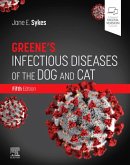Jane E. Sykes (University of California-Davis Professor)
Canine and Feline Infectious Diseases
Jane E. Sykes (University of California-Davis Professor)
Canine and Feline Infectious Diseases
- Gebundenes Buch
- Merkliste
- Auf die Merkliste
- Bewerten Bewerten
- Teilen
- Produkt teilen
- Produkterinnerung
- Produkterinnerung
Covers the advances in the Canine and Feline field. This guide includes 80 case studies that illustrate the clinical relevance of the major infectious disease chapters.
Andere Kunden interessierten sich auch für
![Canine Infectious Diseases Canine Infectious Diseases]() Canine Infectious Diseases52,99 €
Canine Infectious Diseases52,99 €![Canine and Feline Cytopathology Canine and Feline Cytopathology]() Raskin, Rose E., DVM, PhD, DACVP (Professor of Veterinary Clinical PCanine and Feline Cytopathology168,99 €
Raskin, Rose E., DVM, PhD, DACVP (Professor of Veterinary Clinical PCanine and Feline Cytopathology168,99 €![Canine and Feline Dermatology Atlas 2nd Edition Canine and Feline Dermatology Atlas 2nd Edition]() Gustavo Machicote GothCanine and Feline Dermatology Atlas 2nd Edition102,99 €
Gustavo Machicote GothCanine and Feline Dermatology Atlas 2nd Edition102,99 €![Canine and Feline Behavior for Veterinary Technicians and Nurses Canine and Feline Behavior for Veterinary Technicians and Nurses]() Canine and Feline Behavior for Veterinary Technicians and Nurses80,99 €
Canine and Feline Behavior for Veterinary Technicians and Nurses80,99 €![Canine and Feline Behavior, an Issue of Veterinary Clinics of North America: Small Animal Practice Canine and Feline Behavior, an Issue of Veterinary Clinics of North America: Small Animal Practice]() Canine and Feline Behavior, an Issue of Veterinary Clinics of North America: Small Animal Practice107,99 €
Canine and Feline Behavior, an Issue of Veterinary Clinics of North America: Small Animal Practice107,99 €![Greene's Infectious Diseases of the Dog and Cat Greene's Infectious Diseases of the Dog and Cat]() Jane E. Sykes (University of California-Davis Professor)Greene's Infectious Diseases of the Dog and Cat165,99 €
Jane E. Sykes (University of California-Davis Professor)Greene's Infectious Diseases of the Dog and Cat165,99 €![Canine & Feline Gastroenterology Canine & Feline Gastroenterology]() Robert J. Washabau (Professor, Department Chairperson, Department oCanine & Feline Gastroenterology194,99 €
Robert J. Washabau (Professor, Department Chairperson, Department oCanine & Feline Gastroenterology194,99 €-
-
-
Covers the advances in the Canine and Feline field. This guide includes 80 case studies that illustrate the clinical relevance of the major infectious disease chapters.
Hinweis: Dieser Artikel kann nur an eine deutsche Lieferadresse ausgeliefert werden.
Hinweis: Dieser Artikel kann nur an eine deutsche Lieferadresse ausgeliefert werden.
Produktdetails
- Produktdetails
- Verlag: Elsevier Health Sciences
- Seitenzahl: 928
- Erscheinungstermin: 2. August 2013
- Englisch
- Abmessung: 284mm x 222mm x 45mm
- Gewicht: 2858g
- ISBN-13: 9781437707953
- ISBN-10: 1437707955
- Artikelnr.: 38493208
- Herstellerkennzeichnung
- Libri GmbH
- Europaallee 1
- 36244 Bad Hersfeld
- 06621 890
- Verlag: Elsevier Health Sciences
- Seitenzahl: 928
- Erscheinungstermin: 2. August 2013
- Englisch
- Abmessung: 284mm x 222mm x 45mm
- Gewicht: 2858g
- ISBN-13: 9781437707953
- ISBN-10: 1437707955
- Artikelnr.: 38493208
- Herstellerkennzeichnung
- Libri GmbH
- Europaallee 1
- 36244 Bad Hersfeld
- 06621 890
Dr. Sykes is the founder of the International Society of Companion Animal Infectious Diseases; a group dedicated to enhancing control of infectious diseases in animals and thus reducing spread of disease. She has authored several book chapters on canine and feline infectious diseases. She reviews manuscripts for several major international veterinary journals and has been an editor for the Journal of Veterinary Internal Medicine and has served on the editorial board for American Journal of Veterinary Research.
PART I: BASIC PRINCIPLES IN THE DIAGNOSIS AND MANAGEMENT OF SMALL ANIMAL
INFECTION
Section 1. Laboratory Diagnosis of Canine and Feline Infectious Diseases
1. Isolation in Cell Culture
2. Immunoassays
3. Isolation and Identification of Aerobic and Anaerobic Bacteria
4. Isolation and Identification of Fungi
5. Nucleic Acid Detection Assays
Section 2. Anti-Infective Therapy
6. Principles of Anti-Infective Therapy
7. Antiviral and Immunomodulatory Drugs
8. Antibacterial Drugs
9. Antifungal Drugs
10. Antiprotozoal Drugs
Section 3. Basic Principles for Infection Control
11. Infection Control Programs for Dogs and Cats
12. Immunization
PART II: MAJOR INFECTIOUS DISEASES AND THEIR ETIOLOGIC AGENTS
Section 1. Viral Diseases
13. Rabies
14. Canine Parvovirus Infection and Other Viral Enteritides
15. Canine Distemper Virus Infection
16. Canine Herpesvirus Infection
17. Canine Viral Respiratory Infections
18. Infectious Canine Hepatitis
19. Feline Panleukopenia Virus Infection and Other Viral Enteritides
20. Feline Coronavirus Infection
21. Feline Immunodeficiency Virus Infection
22. Feline Leukemia Virus Infection
23. Feline Respiratory Viral Infections
24. Feline Poxvirus Infection
25. Pseudorabies
26. Viral Papillomatosis
27. Vector-Borne and Other Viral encephalitides
Section 2. Bacterial Diseases
28. Ehrlichiosis
29. Anaplasmosis
30. Rocky Mountain Spotted Fever
31. Salmon Poisoning Disease
32. Coxiellosis and Q Fever
33. Chlamydial Infections
34. Streptococcal and Enterococcal Infections
35. Staphylococcus Infections
36. Gram-Negative Bacterial Infections
37. Anaerobic Infections
38. Bordetellosis
39. Cell Wall Deficient Bacterial Infections
40. Mycoplasma Infections
41. Hemoplasma Infections
42. Actinomycosis
43. Nocardiosis
44. Mycobacterial Infections
45. Salmonellosis
46. Enteric Escherichia coli Infections
47. Campylobacteriosis
48. Enteric Clostridial Infections
49. Gastric Helicobacter-Like Infections
50. Leptospirosis
51. Lyme Borreliosis
52. Bartonellosis
53. Canine Brucellosis
54. Tetanus and Botulism
55. Yersinia Pestis (Plague) and Other Yersiniosis
56. Tularemia
57. Bite and Scratch Wound Infections
Section 3. Fungal and Algal Diseases
58. Dermatophytosis
59. Malassezia Infections
60. Blastomycosis
61. Histoplasmosis
62. Cryptococcosis
63. Coccidioidomycosis
64. Sporotrichosis
65. Aspergillosis
66. Rhinosporidiosis
67. Candidiasis
68. Miscellaneous Fungal Diseases
69. Pythiosis, Lagenidiosis and Zygomycosis
70. Protothecosis
71. Pneumocystosis
Section 4. Protozoal Diseases
72. Toxoplasmosis
73. Neosporosis
74. Leishmaniasis
75. Babesiosis
76. Cytauxzoonosis
77. Canine and Feline Hepatozoonosis
78. Trypanosomiasis
79. Giardiasis
80. Trichomoniasis
81. Cryptosporidiosis
82. Isosporiasis
83. Miscellaneous Protozoal Diseases
Section 5: Infections of Selected Organ Systems
84. Pyoderma, Otitis Externa, and Otitis Media
85. Osteomyelitis, Discospondylitis, and Infectious Arthritis
86. Infections of the Cardiovascular System
87. Bacterial Bronchopneumonia and Pyothorax
88. Intra-Abdominal Infections
89. Bacterial Infections of the Genitourinary Tract
90. Bacterial meningitis
Appendix: Vaccination Schedules for Dogs and Cats
INFECTION
Section 1. Laboratory Diagnosis of Canine and Feline Infectious Diseases
1. Isolation in Cell Culture
2. Immunoassays
3. Isolation and Identification of Aerobic and Anaerobic Bacteria
4. Isolation and Identification of Fungi
5. Nucleic Acid Detection Assays
Section 2. Anti-Infective Therapy
6. Principles of Anti-Infective Therapy
7. Antiviral and Immunomodulatory Drugs
8. Antibacterial Drugs
9. Antifungal Drugs
10. Antiprotozoal Drugs
Section 3. Basic Principles for Infection Control
11. Infection Control Programs for Dogs and Cats
12. Immunization
PART II: MAJOR INFECTIOUS DISEASES AND THEIR ETIOLOGIC AGENTS
Section 1. Viral Diseases
13. Rabies
14. Canine Parvovirus Infection and Other Viral Enteritides
15. Canine Distemper Virus Infection
16. Canine Herpesvirus Infection
17. Canine Viral Respiratory Infections
18. Infectious Canine Hepatitis
19. Feline Panleukopenia Virus Infection and Other Viral Enteritides
20. Feline Coronavirus Infection
21. Feline Immunodeficiency Virus Infection
22. Feline Leukemia Virus Infection
23. Feline Respiratory Viral Infections
24. Feline Poxvirus Infection
25. Pseudorabies
26. Viral Papillomatosis
27. Vector-Borne and Other Viral encephalitides
Section 2. Bacterial Diseases
28. Ehrlichiosis
29. Anaplasmosis
30. Rocky Mountain Spotted Fever
31. Salmon Poisoning Disease
32. Coxiellosis and Q Fever
33. Chlamydial Infections
34. Streptococcal and Enterococcal Infections
35. Staphylococcus Infections
36. Gram-Negative Bacterial Infections
37. Anaerobic Infections
38. Bordetellosis
39. Cell Wall Deficient Bacterial Infections
40. Mycoplasma Infections
41. Hemoplasma Infections
42. Actinomycosis
43. Nocardiosis
44. Mycobacterial Infections
45. Salmonellosis
46. Enteric Escherichia coli Infections
47. Campylobacteriosis
48. Enteric Clostridial Infections
49. Gastric Helicobacter-Like Infections
50. Leptospirosis
51. Lyme Borreliosis
52. Bartonellosis
53. Canine Brucellosis
54. Tetanus and Botulism
55. Yersinia Pestis (Plague) and Other Yersiniosis
56. Tularemia
57. Bite and Scratch Wound Infections
Section 3. Fungal and Algal Diseases
58. Dermatophytosis
59. Malassezia Infections
60. Blastomycosis
61. Histoplasmosis
62. Cryptococcosis
63. Coccidioidomycosis
64. Sporotrichosis
65. Aspergillosis
66. Rhinosporidiosis
67. Candidiasis
68. Miscellaneous Fungal Diseases
69. Pythiosis, Lagenidiosis and Zygomycosis
70. Protothecosis
71. Pneumocystosis
Section 4. Protozoal Diseases
72. Toxoplasmosis
73. Neosporosis
74. Leishmaniasis
75. Babesiosis
76. Cytauxzoonosis
77. Canine and Feline Hepatozoonosis
78. Trypanosomiasis
79. Giardiasis
80. Trichomoniasis
81. Cryptosporidiosis
82. Isosporiasis
83. Miscellaneous Protozoal Diseases
Section 5: Infections of Selected Organ Systems
84. Pyoderma, Otitis Externa, and Otitis Media
85. Osteomyelitis, Discospondylitis, and Infectious Arthritis
86. Infections of the Cardiovascular System
87. Bacterial Bronchopneumonia and Pyothorax
88. Intra-Abdominal Infections
89. Bacterial Infections of the Genitourinary Tract
90. Bacterial meningitis
Appendix: Vaccination Schedules for Dogs and Cats
PART I: BASIC PRINCIPLES IN THE DIAGNOSIS AND MANAGEMENT OF SMALL ANIMAL
INFECTION
Section 1. Laboratory Diagnosis of Canine and Feline Infectious Diseases
1. Isolation in Cell Culture
2. Immunoassays
3. Isolation and Identification of Aerobic and Anaerobic Bacteria
4. Isolation and Identification of Fungi
5. Nucleic Acid Detection Assays
Section 2. Anti-Infective Therapy
6. Principles of Anti-Infective Therapy
7. Antiviral and Immunomodulatory Drugs
8. Antibacterial Drugs
9. Antifungal Drugs
10. Antiprotozoal Drugs
Section 3. Basic Principles for Infection Control
11. Infection Control Programs for Dogs and Cats
12. Immunization
PART II: MAJOR INFECTIOUS DISEASES AND THEIR ETIOLOGIC AGENTS
Section 1. Viral Diseases
13. Rabies
14. Canine Parvovirus Infection and Other Viral Enteritides
15. Canine Distemper Virus Infection
16. Canine Herpesvirus Infection
17. Canine Viral Respiratory Infections
18. Infectious Canine Hepatitis
19. Feline Panleukopenia Virus Infection and Other Viral Enteritides
20. Feline Coronavirus Infection
21. Feline Immunodeficiency Virus Infection
22. Feline Leukemia Virus Infection
23. Feline Respiratory Viral Infections
24. Feline Poxvirus Infection
25. Pseudorabies
26. Viral Papillomatosis
27. Vector-Borne and Other Viral encephalitides
Section 2. Bacterial Diseases
28. Ehrlichiosis
29. Anaplasmosis
30. Rocky Mountain Spotted Fever
31. Salmon Poisoning Disease
32. Coxiellosis and Q Fever
33. Chlamydial Infections
34. Streptococcal and Enterococcal Infections
35. Staphylococcus Infections
36. Gram-Negative Bacterial Infections
37. Anaerobic Infections
38. Bordetellosis
39. Cell Wall Deficient Bacterial Infections
40. Mycoplasma Infections
41. Hemoplasma Infections
42. Actinomycosis
43. Nocardiosis
44. Mycobacterial Infections
45. Salmonellosis
46. Enteric Escherichia coli Infections
47. Campylobacteriosis
48. Enteric Clostridial Infections
49. Gastric Helicobacter-Like Infections
50. Leptospirosis
51. Lyme Borreliosis
52. Bartonellosis
53. Canine Brucellosis
54. Tetanus and Botulism
55. Yersinia Pestis (Plague) and Other Yersiniosis
56. Tularemia
57. Bite and Scratch Wound Infections
Section 3. Fungal and Algal Diseases
58. Dermatophytosis
59. Malassezia Infections
60. Blastomycosis
61. Histoplasmosis
62. Cryptococcosis
63. Coccidioidomycosis
64. Sporotrichosis
65. Aspergillosis
66. Rhinosporidiosis
67. Candidiasis
68. Miscellaneous Fungal Diseases
69. Pythiosis, Lagenidiosis and Zygomycosis
70. Protothecosis
71. Pneumocystosis
Section 4. Protozoal Diseases
72. Toxoplasmosis
73. Neosporosis
74. Leishmaniasis
75. Babesiosis
76. Cytauxzoonosis
77. Canine and Feline Hepatozoonosis
78. Trypanosomiasis
79. Giardiasis
80. Trichomoniasis
81. Cryptosporidiosis
82. Isosporiasis
83. Miscellaneous Protozoal Diseases
Section 5: Infections of Selected Organ Systems
84. Pyoderma, Otitis Externa, and Otitis Media
85. Osteomyelitis, Discospondylitis, and Infectious Arthritis
86. Infections of the Cardiovascular System
87. Bacterial Bronchopneumonia and Pyothorax
88. Intra-Abdominal Infections
89. Bacterial Infections of the Genitourinary Tract
90. Bacterial meningitis
Appendix: Vaccination Schedules for Dogs and Cats
INFECTION
Section 1. Laboratory Diagnosis of Canine and Feline Infectious Diseases
1. Isolation in Cell Culture
2. Immunoassays
3. Isolation and Identification of Aerobic and Anaerobic Bacteria
4. Isolation and Identification of Fungi
5. Nucleic Acid Detection Assays
Section 2. Anti-Infective Therapy
6. Principles of Anti-Infective Therapy
7. Antiviral and Immunomodulatory Drugs
8. Antibacterial Drugs
9. Antifungal Drugs
10. Antiprotozoal Drugs
Section 3. Basic Principles for Infection Control
11. Infection Control Programs for Dogs and Cats
12. Immunization
PART II: MAJOR INFECTIOUS DISEASES AND THEIR ETIOLOGIC AGENTS
Section 1. Viral Diseases
13. Rabies
14. Canine Parvovirus Infection and Other Viral Enteritides
15. Canine Distemper Virus Infection
16. Canine Herpesvirus Infection
17. Canine Viral Respiratory Infections
18. Infectious Canine Hepatitis
19. Feline Panleukopenia Virus Infection and Other Viral Enteritides
20. Feline Coronavirus Infection
21. Feline Immunodeficiency Virus Infection
22. Feline Leukemia Virus Infection
23. Feline Respiratory Viral Infections
24. Feline Poxvirus Infection
25. Pseudorabies
26. Viral Papillomatosis
27. Vector-Borne and Other Viral encephalitides
Section 2. Bacterial Diseases
28. Ehrlichiosis
29. Anaplasmosis
30. Rocky Mountain Spotted Fever
31. Salmon Poisoning Disease
32. Coxiellosis and Q Fever
33. Chlamydial Infections
34. Streptococcal and Enterococcal Infections
35. Staphylococcus Infections
36. Gram-Negative Bacterial Infections
37. Anaerobic Infections
38. Bordetellosis
39. Cell Wall Deficient Bacterial Infections
40. Mycoplasma Infections
41. Hemoplasma Infections
42. Actinomycosis
43. Nocardiosis
44. Mycobacterial Infections
45. Salmonellosis
46. Enteric Escherichia coli Infections
47. Campylobacteriosis
48. Enteric Clostridial Infections
49. Gastric Helicobacter-Like Infections
50. Leptospirosis
51. Lyme Borreliosis
52. Bartonellosis
53. Canine Brucellosis
54. Tetanus and Botulism
55. Yersinia Pestis (Plague) and Other Yersiniosis
56. Tularemia
57. Bite and Scratch Wound Infections
Section 3. Fungal and Algal Diseases
58. Dermatophytosis
59. Malassezia Infections
60. Blastomycosis
61. Histoplasmosis
62. Cryptococcosis
63. Coccidioidomycosis
64. Sporotrichosis
65. Aspergillosis
66. Rhinosporidiosis
67. Candidiasis
68. Miscellaneous Fungal Diseases
69. Pythiosis, Lagenidiosis and Zygomycosis
70. Protothecosis
71. Pneumocystosis
Section 4. Protozoal Diseases
72. Toxoplasmosis
73. Neosporosis
74. Leishmaniasis
75. Babesiosis
76. Cytauxzoonosis
77. Canine and Feline Hepatozoonosis
78. Trypanosomiasis
79. Giardiasis
80. Trichomoniasis
81. Cryptosporidiosis
82. Isosporiasis
83. Miscellaneous Protozoal Diseases
Section 5: Infections of Selected Organ Systems
84. Pyoderma, Otitis Externa, and Otitis Media
85. Osteomyelitis, Discospondylitis, and Infectious Arthritis
86. Infections of the Cardiovascular System
87. Bacterial Bronchopneumonia and Pyothorax
88. Intra-Abdominal Infections
89. Bacterial Infections of the Genitourinary Tract
90. Bacterial meningitis
Appendix: Vaccination Schedules for Dogs and Cats








